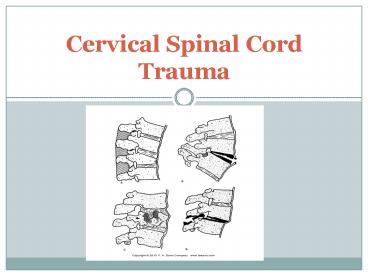Cervical Spinal Cord Trauma PowerPoint PPT Presentation
1 / 12
Title: Cervical Spinal Cord Trauma
1
Cervical Spinal Cord Trauma
2
Cervical Spinal Cord Injuries
- History
- Current occurrence
- Spinal Cord inhibited by two MOI
- On vs. off-the-field
- 4 no-no signs and symptoms
- Risk factors
3
Cervical Fractures
- MOI
- axial loading, possibly with flexion
- usually occurs to 4-6th cervical vertebrae
- dislocation may occur if rotation occurs with it
- SS
- point tenderness along neck
- decreased motion
- muscle spasm
- pain in neck and chest
- numbness in trunk and limbs
- weakness or paralysis
- sometimes no SS
- Tx Hospital
4
Cervical Dislocations
- MOI
- violent flexion with rotation (ex- diving into a
pool) - occurs more frequently than fractures
- usually to 4-6th cervical vertebrae
- more serious than fractures
- SS
- same as fracture
- head tilted toward dislocated side
- Tx Hospital
5
Transient Quadriplegia
- Transient
- MOI
- C-spine forced into hyperextension, hyperflexion,
or axial load - Stenosis esp. at C3-C4 level
- Neural arch abnormalities, esp. posteriorly
- SS
- Initially resemble catastrophic injury
- Clear within 15 min. to 48 hours
6
Spinal Cord Injuries
- 4 basic MOI
- Laceration by bony fragments
- Hemorrhage
- Contusion
- Shock
- Can act together or separately
7
Spinal Cord Injuries
- Laceration
- Caused by combination of dislocation and fracture
of cervical vertebra - Edges cut and tear nerve roots or spinal cord and
cause varying degrees of paralysis below injury
8
Spinal Cord Injuries
- Hemorrhage
- Develops from vertebral fractures and most
dislocations - Sprains and strains can also cause this
- Seldom causes harmful effects outside of spinal
cord but within it causes irreparable damage
9
Spinal Cord Injuries
- Contusion
- Can arise from violent force applied to the neck
but without causing a dislocation or fracture - May result from sudden temporary displacement of
a vertebrae (subluxation) - Results in varying degrees of temporary or
permanent damage
10
Spinal Cord Injuries
- Shock
- Arises from severe neck twist or snap
- Signs/symptoms of a spinal cord injury
- Unable to move or has weakness in parts of the
body - Numbness and tingling in arms and/or legs
- Able to move limbs freely and has no other SS
than a stiff neck in a short period of time - Considered a mild contusion
11
Nerve Root Injuries
- MOI
- same as to brachial plexus
- SS
- Burning, electrical shock, numbness and
tingling - Varying levels of decreased motor function and
sensation below level of injury - Traction MOI allows SS to resolve more quickly
- Extension and side bending associated with
chronic MOI more likely to have degenerative
changes - CT scan, MRI and EMG used to identify traumatized
nerve
12
Nerve Root Injuries (cont.)
- Neck pain NOT associated with this
- Will subside within minutes with initial injury
SS diminish more slowly with repeated trauma - Must rule out fractures and dislocations
- Diminished grip strength
- C3 impaired respiration, impaired neck movement
- C4/C5 return of shoulder function
- C5/C6 return of elbow flexion and wrist
extension - C6/C7 return of elbow extension and wrist
flexion - C8/T1- return of grip function
- Handle with extreme caution to minimize damage

